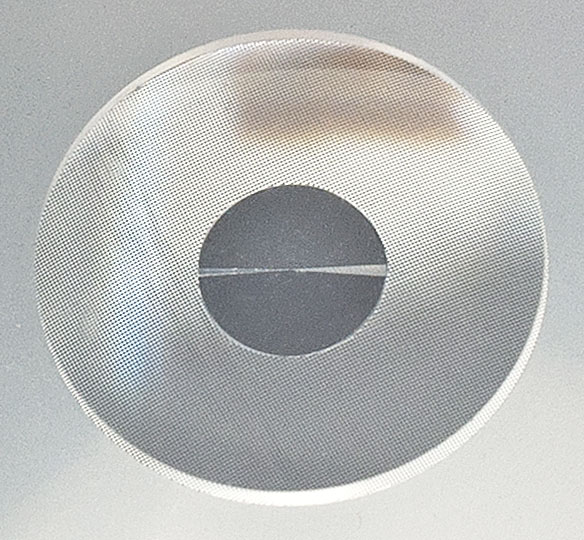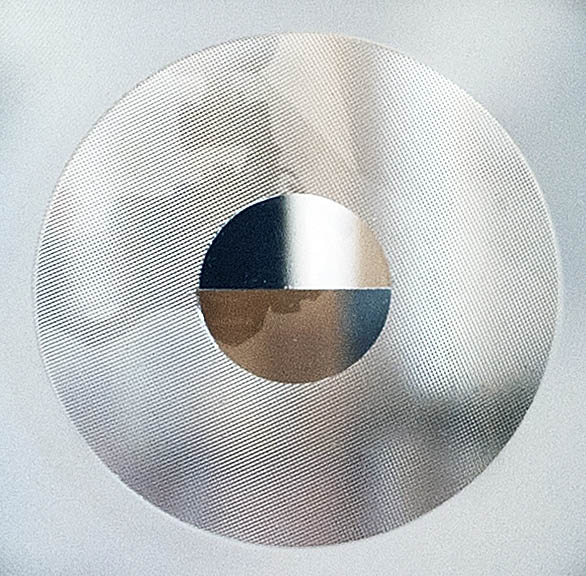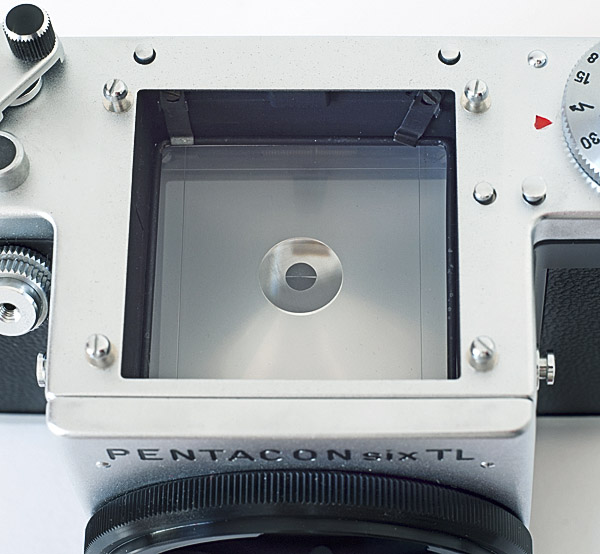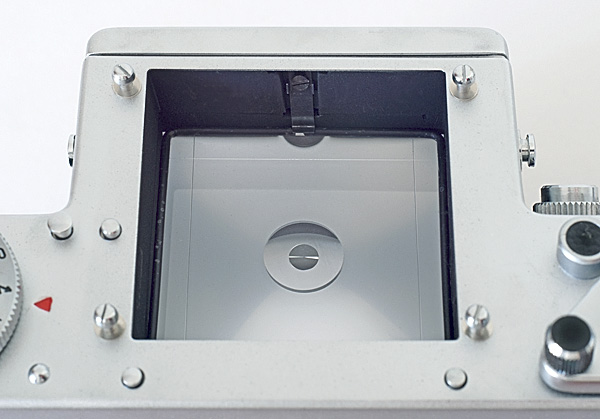by TRA
A Focussing
Screen from Kiev for the Pentacon Six

Focussing screen from Kiev
(What appear to be marks on the screen
are the reflection of the camera, the tripod and the
photographer’s hand.)
[ks7.jpg]
A Ukrainian fresnel focussing screen for the Pentacon Six is sometimes advertised.
I bought one from an eBay trader known as
hohol or h_o_h_o_l. I believe that this is the
trading name of Yuri Davidenko, who also appears to be
behind the DVDTech website. In April 2016, I
can no longer see this screen on the DVDTech
website. However it is
available from Araxfoto.
This screen was described as “Fresnel bright focussing screen Pentacon Six New”. What is it like? This may be a screen that has been designed for the Kiev 60 or the Kiev 88, that has been cut down in size in order to fit the Pentacon Six. I no longer have either of these cameras, and so cannot make a comparison.
First, it is a perfect fit. It has the following features:
- fresnel screen
- rangefinder wedges
- microprism ring to aid focussing
- two horizontal and two vertical lines near the edges of the frame, as composition aids.
Fresnel screen
| The
principle The principle of the fresnel lens is that it distributes the light evenly over a much wider area. Fresnel lenses were apparently first developed to increase the size and effectiveness of lights used by lighthouses. They normally consist of a series of fine concentric circles (or occasionally, parallel lines). In cameras, fresnel focussing screens distribute the light across the surface of the screen, making the screen image much brighter than it is on the original, standard screen, especially away from the centre of the screen. The
reality |
 [ks7fres.jpg] |
Rangefinder wedges
| The
principle The idea of rangefinder wedges is that if a straight line edge is viewed through the rangefinder wedges, if it is in focus it will appear as a straight line. If it is out of focus, the two parts of the edge will not line up. The
reality The rangefinder wedges on this screen are excellent, possibly better than the ones on the Rollei screen. They really make focussing easy with most subjects. |
 The two semi-circles in the centre are the rangefinder wedges. Their surfaces are inclined at opposite angles. [ks6crop.jpg] |
Microprism ring round rangefinder wedges
| The
principle The idea of microprisms is that these little pyramid-shaped points on the surface of the screen become visible in the viewfinder when the image is out of focus, and disappear when it is in focus, which makes finding the point of sharp focus easier. The
reality |
 [ks7crop.jpg] (The shadows on the screen are the reflection of the camera, the tripod and the photographer’s hand – the picture was of course taken with the prism and the waist-level finder removed. With either of these in place, reflections will not be seen on the screen.) |
Composition aids
The principal area of the screen has no markings. However, there are four composition-guidance lines, each one a little way in from the corresponding edge – visible in the photograph at the top of this page.
These can help the user to know when (s)he is holding the camera horizontally. The lines on this screen are clearly visible without – in my opinion – impeding the clear view of the subject to be photographed. They may also help the photographer who is composing for a picture that will cropped to produce a horizontal or a vertical image.
I personally like the greater number of composition lines on the Rollei MK screen, but some people do not, preferring a largely plain screen. They will probably like the Ukrainian screen better than the Rollei screen. (The Pentacon Six metering prism also has curved markings that show the area covered by the meter, and these are of course visible in the viewfinder.)
Installation
The screen has a flat upper surface, and
is supplied with no retaining wire. The retaining
wire for the original screen is deeply curved, to follow
the curvature of the standard screen, so it is not a
natural good fit for this screen.
 To keep it in place, he has used at the back the two long clips that come with the camera when it is supplied with the standard screen (i.e., always, when it was new). |
 As an alternative solution, one website has suggested using a small piece of rubber (eraser) between the base of the front clip and the surface of the screen. |
Conclusion
This is a thin, light-weight screen that must reduce the total weight of the Pentacon Six by a few grams (but surely not enough for the user to notice the difference!).
The screen is very economically-priced
and in early 2012 it was readily available from www.dvdtechnik.com
in Ukraine. However, in April 2016 I could
only find it offered by Araxfoto.com. On
20.4.16, the following link went straight to the screen:
http://araxfoto.com/accessories/pentacon_screen/
and on 6th January 2017 this link still works.
Arax also sometimes sells the screen on eBay. I
suggest that you do a search on eBay for "P-SIX
FRESNEL BRIGHT FOCUSING SCREEN for Pentacon Six
cameras ARAX. Made in Kiev". On the basis of my own
experience, I recommend Araxfoto as a
reliable seller.
| Another highly-recommended
seller is Zhanna, who trades on eBay as Grizzly33bear.
On 5th January 2017 she wrote to me: “we
always had it and have it now! These screens are
our permanent offer, here it is, http://www.ebay.com/itm/322222999410”
She also gives the following link: http://stores.ebay.com/grizzly33bear
Over the years I have bought various items from “Grizzly Bear”, and have always found her service and the products that she sells excellent. My apologies for not having seen her offer of this screen when I researched this last April. |
I am delighted that in 2017 two such
excellent sellers still offer items for use with the
Pentacon Six.
You may of course also occasionally find the screen listed on eBay, perhaps with a slightly different description, from other vendors who may have a single screen that they wish to sell.
It is an extremely good screen, and I am very pleased to have it in one of my Pentacon Sixes.
To go back to the introduction to the focussing screens, click here.
To see notes on how to change focussing screens, click here.
To go on to information on accessory
shoes, click here.
To go to introduction to the cameras, click here.
To go back to the section on viewing aids, click here.
To choose other options, click below.
Home
© TRA First published: April 2012 Latest revision: January 2017